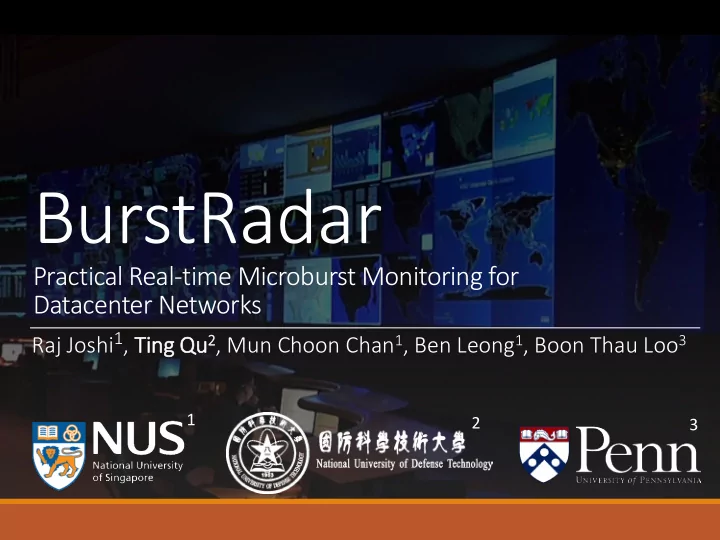

BurstRadar Practical Real-time Microburst Monitoring for Datacenter Networks Raj Joshi 1 , Ti Ting Qu 2 , Mun Choon Chan 1 , Ben Leong 1 , Boon Thau Loo 3 1 2 3
Microbursts (µbursts) Events of intermittent congestion lasting 10’s or 100’s of µs ◦ Common Causes: TCP Incast Bursty UDP traffic Senders TCP segment offloading ◦ Intermittent increase in latency variability Receiver ◦ Network jitter and Packet loss …… BurstRadar (APSys ‘18) 2
Modern Datacenter Networks > 10 Gbps 10’s of µs Latency Small amounts of queueing (microbursts): Performance BurstRadar (APSys ‘18) 3
Modern Datacenter Networks Detect the occurrence of µbursts & identify the contributing flows! BurstRadar (APSys ‘18) 4
Detecting & characterizing µbursts is hard Measurement study from FB’s datacenter ◦ Last for less than 200 µs ◦ Occur unpredictably Traditional sampling-based techniques ◦ Cannot even detect microbursts Commercial Solutions ◦ Can detect the occurrence of microbursts ◦ Provide no information about the cause BurstRadar (APSys ‘18) 5
New Advancements Programmable dataplanes and dataplane telemetry In-band Telemetry (INT) ◦ Adds queuing telemetry info into packets & exports it to monitoring servers from the last-hop switches BurstRadar (APSys ‘18) 6
Challenges: Effective & real-time monitoring Using INT to detect µbursts is wasteful ◦ Need to capture and export/process telemetry data for all packets Since µbursts are unpredictable ◦ Expensive computation and delay Correlate monitoring data from different points in the network BurstRadar (APSys ‘18) 7
Solution: Out-band Key Insight: Egress Port µbursts are localized to a Queues switch’s egress port queue Switch’s Queuing Engine Key Idea: ◦ We can detect the microburst directly on the switch where it happens BurstRadar (APSys ‘18) 8
Solution: egress pipeline ◦ Switching ASIC’s “Buffer and Queuing Engine” (BQE) does not provide any support to peek into the contents of any queue BurstRadar (APSys ‘18) 9
BurstRadar Overview Queuing Telemetry Markbit Egress Ports (metadata) (metadata) Snapshot Courier Pkt Ring Buffer Algorithm Generator Egress Processing Pipeline Egress Port Egress Deparser Queues BurstRadar (APSys ‘18) 10
BurstRadar Overview Egress Ports Courier Packet Snapshot Courier Pkt Ring Buffer Algorithm Generator Egress Processing Pipeline Egress Port Egress Deparser Queues Mirror Port Queue BurstRadar (APSys ‘18) 11
BurstRadar Overview Egress Ports Courier Packet Snapshot Courier Pkt Ring Buffer Algorithm Generator Egress Processing Pipeline Egress Port Egress Deparser Queues Mirror Port Queue BurstRadar (APSys ‘18) 12
BurstRadar Overview Telemetry Info: - Pkt 5-tuple Egress Ports Courier Packet - Queuing telemetry data Snapshot Courier Pkt Ring Buffer Algorithm Generator Egress Processing Pipeline Egress Port Egress Deparser Queues Mirror Port Queue Mirror Port BurstRadar (APSys ‘18) 13
BurstRadar Overview Egress Ports Snapshot Courier Pkt Ring Buffer Algorithm Generator Egress Processing Pipeline Egress Port Egress Deparser Queues Mirror Port BurstRadar (APSys ‘18) 14
Snapshot Algorithm BurstRadar (APSys ‘18) Courier Pkt Generator Ring Buffer 15
Snapshot Algorithm “Snapshot” the telemetry info of only the packets involved in µbursts Telemetry info: 5-tuple (packet header) ingress/egress timestamps (metadata) enqueue/dequeue queue depths BurstRadar (APSys ‘18) 16
Latency Increase Threshold ◦ Eg. RTT = 50 µ s, threshold = 30%, i.e., maximum delay = 15 µ s Snapshot Algorithm Queue Snapshots Snapshot Algorithm ◦ Each packet reports deqQdepth ◦ if deqQdepth > threshold, then mark pkt snapshot ◦ Track remaining bytes in the queue ◦ elif tracked bytes still remaining then mark pkt snapshot BurstRadar (APSys ‘18) 17
Snapshot Algorithm BurstRadar (APSys ‘18) Courier Pkt Generator Ring Buffer 18
Courier Pkt Generator “Courier” Packets transport the telemetry info via the switch’s mirror port (out-of-band) All the data stays together Avoids the expensive correlation on the monitoring servers BurstRadar (APSys ‘18) 19
Courier Pkt Generator Each marked packet generate new courier packet clone egress to egress, clone_e2e ◦ Copy of the exiting marked packet ◦ Place it in the egress queue of the mirror port BurstRadar (APSys ‘18) 20
Snapshot Algorithm BurstRadar (APSys ‘18) Courier Pkt Generator Ring Buffer 21
Ring Buffer “Ring Buffer” temporarily stores the telemetry info of marked packets until they can be copied into the courier packets. BurstRadar (APSys ‘18) 22
Evaluation BurstRadar (APSys ‘18) 23
Evaluation Setup Hardware Testbed BurstRadar Prototype Send/Receive µburst Traffic ◦ About 550 lines of p4 code Generated µburst Traffic Traces ◦ µbursts data for “web” and “cache” traffic [IMC ‘17] Compare BurstRadar against ◦ In-band Telemetry (INT) dataplane-based solution ◦ “Oracle” Algorithm ground truth (exact pkts in µbursts) BurstRadar (APSys ‘18) 24
Efficiency 5 5% RTT 10 times less packets compared to INT e: 5% RTT ≈ 1.25µs of queuing @10Gbps in our testbed No Note: BurstRadar (APSys ‘18) 25
Handling Concurrent µbursts 0.5 300 entries (8.7KB SRAM) 10 concurrent µbursts (< 0.5%) No Note: e: 1000 entries (29KB SRAM) fully handle 10 concurrent µbursts BurstRadar (APSys ‘18) 26
Dataplane Resource Utilization Tofino Resource Utilization (Ring Buffer = 1000 entries) Reso source ce switch ch.p4* p4* BurstRadar Combined Match Crossbar 50.13% 3.39% 53.52% Hash Bits 32.35% 4.83% 37.18% SRAM 29.79% 4.06% 33.85% TCAM 28.47% 0.69% 29.16% VLIW Actions 34.64% 4.69% 39.33% Stateful ALUs 15.63% 12.5% 28.13% * resource utilization of a fully-featured datacenter ToR switch Very little resources combined with switch.p4 BurstRadar (APSys ‘18) 27
Conclusion ◦ Microburst monitoring is important - High impact on performance ◦ BurstRadar can detect and identify Microbursts effectively and continuously - Capture and report the telemetry information of only the packets involved in microbursts ◦ BurstRadar demonstrates that modern programmable ASICs have made it practical to detect and characterize microbursts at multi-gigabit line rates in high-speed datacenter networks. BurstRadar (APSys ‘18) 28
BurstRadar (APSys ‘18) 29
Recommend
More recommend